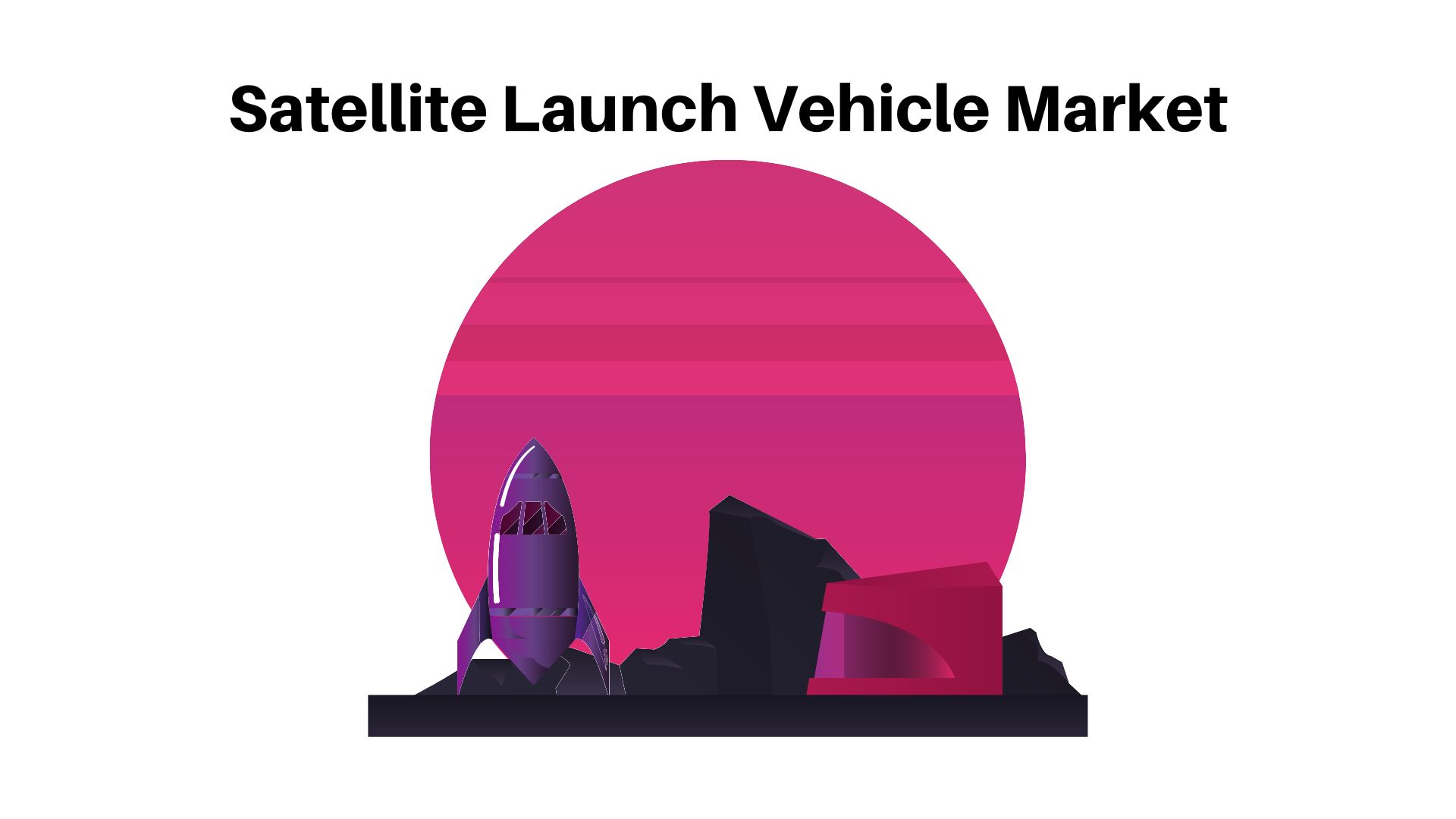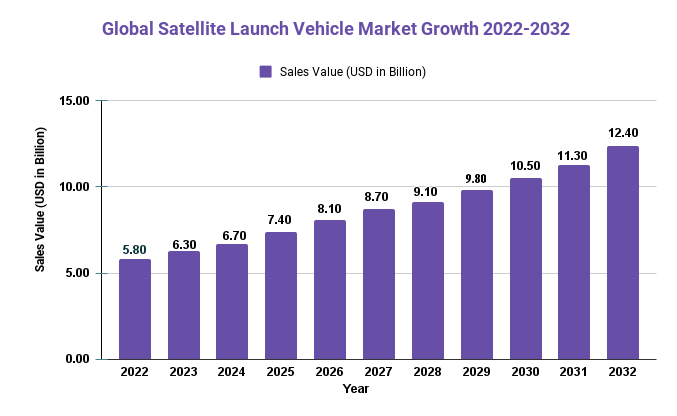Satellite Launch Vehicle Market Expected To Reach CAGR Value Of Over 8% By 2032

Page Contents
Market Overview
Published Via 11Press: In 2022, the satellite launch vehicle market was estimated to be worth USD 5.8 billion and reach its peak value of USD 12.4 billion by 2032 at an annual compound growth rate (CAGR) of 8% between 2022 and 2032.
The satellite launch vehicle market is experiencing rapid growth due to increasing demand for commercial, government, and military satellites. These satellites serve a variety of purposes like communication, navigation, earth observation, and scientific research. The market is highly competitive with several key players operating within it such as SpaceX, Arianespace, United Launch Alliance and China Aerospace Science and Technology Corporation.
Geographically, North America dominates the market due to major players such as SpaceX, United Launch Alliance, and Blue Origin. The Asia-Pacific region is expected to experience rapid growth over the forecast period due to increasing demand for commercial and military satellite launches in countries like China, India, and Japan. Overall, the global satellite launch vehicle market size is forecasted to expand at an impressive rate over the coming years, buoyed by increasing demand for commercial, military, and scientific satellite launches along with advancements in launch vehicle technologies.

Key Takeaways
- The global satellite launch vehicle market is projected to experience strong growth over the coming years, driven by rising demand for satellite launches for communication, navigation, and earth observation applications.
- The market is highly competitive, with several leading players operating within it such as SpaceX, Arianespace, United Launch Alliance and China Aerospace Science and Technology Corporation.
- Reusable launch vehicles are becoming more and more popular, offering significant cost savings over traditional expendable launch vehicles.
- The Asia-Pacific region is expected to experience the fastest growth in satellite launch vehicles, driven by rising demand for communication and earth observation satellites.
Would you like to access the statistical information, graphs, and key players' tactics? click here
Regional Snapshot
North America dominates the global satellite launch vehicle market, led by key players such as SpaceX and United Launch Alliance. However, Asia-Pacific is expected to experience rapid growth in this space due to increasing demand for communication satellites in countries like China and India. Europe also plays a significant role in this space race, with Arianespace dominating this sector.
Drivers
- Growing demand for commercial and military satellite launches: The satellite launch vehicle market is being driven by an increase in commercial and military satellite launches. As more satellites are being used for communication, navigation, weather monitoring, and other purposes; demand for satellite launch vehicles is expected to increase.
- Technological Advancements: The satellite launch vehicle market is being driven by technological progress. With the development of new technologies like reusable rockets and electric propulsion systems, the cost to launch satellites into space is expected to decrease, making it more accessible for commercial as well as military customers alike.
- Growing Interest in Space Exploration: The growing interest in space exploration is propelling the satellite launch vehicle market. As more countries and private companies invest in space exploration, demand for satellite launch vehicles is expected to rise.
- Government Support: Government support in the form of funding and policy initiatives is propelling the satellite launch vehicle market. Governments around the world are investing in space exploration and satellite technology, creating opportunities for players in this space launch vehicle market.
Restraints
- High Cost of Satellite Launch Vehicles: One major obstacle in the satellite launch vehicle market is its high price point. Developing and launching a satellite launch vehicle requires extensive investment, which restricts how many companies can enter this lucrative sector.
- Limited Launch Sites: Another obstacle facing the satellite launch vehicle market is a shortage of launch sites around the world. With only a few designated launch pads worldwide, the capacity for satellite launches may be limited, potentially restricting the market growth.
- Regulatory Challenges: Regulators worldwide have strict regulations for space launches, making it difficult for companies to acquire the necessary licenses and approvals.
- Competition: The satellite launch vehicle market is facing competition from other methods of launching satellites into space, such as air-launched rockets and reusable space planes. This competition could restrict market growth by decreasing demand for satellite launch vehicles.
View Detailed TOC of the Report: https://market.us/report/satellite-launch-vehicle-market/table-of-content/
Opportunities
- Growing demand for satellite-based services such as communication, navigation, and earth observation.
- Increased investment by governments and private organizations in space exploration and satellite launch activities.
- Satellite launch vehicle technologies and innovations such as reusable launch vehicles have been evolving quickly to keep up with growing demands for small satellite launch vehicles to accommodate emerging applications like remote sensing, communication, and scientific research.
Challenges
- High development and launch costs associated with satellite launch vehicles.
- Intense competition among players in the market, especially within the small satellite launch vehicle segment.
- Technological difficulties involved in designing and developing satellite launch vehicle platforms.
- Stringent regulatory oversight exists for the launch and operation of satellites in space.
Recent Developments
- Development of reusable launch vehicles such as SpaceX's Falcon 9, Blue Origin's New Shepard, and Rocket Lab's Electron.
- Introduction of small satellite launches vehicles like Rocket Lab's Electron and Virgin Orbit's LauncherOne.
- Government initiatives and programs to encourage satellite launch activities, such as NASA's Commercial Orbital Transportation Services (COTS) program.
- Satellite launch vehicles must develop new propulsion technologies, such as electric propulsion systems, to increase their efficiency and cost-efficiency.
Key Market Segments
Type
- Partially Reusable
- Fully Reusable
Application
- Civil Satellite Launch
- Military Satellite Launch
Key Market Players
- Lockheed Martin
- Boeing
- Mitsubishi Heavy Industries
- Northrop Grumman
- Airbus
- Bellatrix Aerospace
- Bigelow Aerospace
- Masten Space Systems
- Space Exploration Technologies
- Virgin Galactic
- Blue Origin
- Armadillo Aerospace
Report Scope
| Report Attribute | Details |
| The market size value in 2022 | USD 5.8 Bn |
| Revenue forecast by 2032 | USD 12.4 Bn |
| Growth Rate | CAGR Of 8% |
| Regions Covered | North America, Europe, Asia Pacific, Latin America, and Middle East & Africa, and Rest of the World |
| Historical Years | 2017-2022 |
| Base Year | 2022 |
| Estimated Year | 2023 |
| Short-Term Projection Year | 2028 |
| Long-Term Projected Year | 2032 |
Frequently Asked Questions
Q: What is a satellite launch vehicle?
A: A satellite launch vehicle is an electric rocket-powered craft designed to launch satellites into orbit around Earth or deep space.
Q: What are the different types of satellite launch vehicles?
A: Launch vehicles come in two varieties: expendable launch vehicles (ELVs) and reusable launch vehicles (RLVs). ELVs are intended to be used only once and then discarded after launch; on the other hand, RLVs can be reused multiple times, thus cutting down on launch costs considerably.
Q: What are the primary applications of satellite launch vehicles?
A: Satellite launch vehicles have a variety of uses, such as communication, navigation, earth observation, scientific research projects, and military/defense purposes.
Q: What are the advantages of reusable launch vehicles?
Reusable launch vehicles offer several advantages over expendable ones, such as reduced launch costs, higher launch frequency, and improved sustainability.
Q: What are the challenges associated with launching satellites into space?
A: Launching satellites into orbit poses several challenges, such as the high cost of launch, technological complexity in designing and developing launch vehicles, and regulatory restrictions governing satellite operations in space.
The team behind market.us, marketresearch.biz, market.biz and more. Our purpose is to keep our customers ahead of the game with regard to the markets. They may fluctuate up or down, but we will help you to stay ahead of the curve in these market fluctuations. Our consistent growth and ability to deliver in-depth analyses and market insight has engaged genuine market players. They have faith in us to offer the data and information they require to make balanced and decisive marketing decisions.